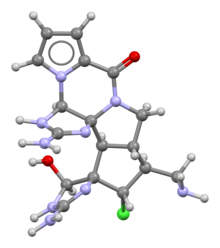Chemistry:Palau'amine

| |

| |
| Names | |
|---|---|
| Preferred IUPAC name
(3aR,4′R,5′S,10aS,11S,12S,13aS,13bR)-2,2′-Diamino-11-(aminomethyl)-12-chloro-5′-hydroxy-1,1′,3a,5′,10a,11,12,13a-octahydro-8H,10H-spiro[cyclopenta[3,4]pyrrolo[1,2-a]imidazo[4,5-b]pyrrolo[1,2-d]pyrazine-13,4′-imidazol]-8-one | |
| Identifiers | |
3D model (JSmol)
|
|
| ChEMBL | |
| ChemSpider | |
| MeSH | C438976 |
PubChem CID
|
|
| UNII | |
| |
| |
| Properties | |
| C17H22ClN9O2 | |
| Molar mass | 419.87 g·mol−1 |
Except where otherwise noted, data are given for materials in their standard state (at 25 °C [77 °F], 100 kPa). | |
| Infobox references | |
Palau'amine is a toxic alkaloid compound synthesized naturally by certain species of sea sponges. The name of the molecule derives from the island nation of Palau, near where the first sponge species discovered to produce it, Stylotella agminata, is found. It has since been isolated in other sponges, including Stylissa massa.[1]
The substance was first isolated from Stylotella agminata, a sponge found in the southwest Pacific Ocean, and described in 1993.[2] Containing nine nitrogen atoms, the molecule is considered highly complex. The precise atomic structure was pinned down in 2007,[3] and two years later, the molecule was synthesized in the lab of Phil Baran at the Scripps Research Institute in La Jolla, California.[4][5] Early efforts towards its synthesis were directed at a misassigned structure featuring a cis- rather than trans-5/5 ring fusion, an error that was made because the trans-5/5 ring system is some 6 kcal/mol less stable than the cis-configured system.[6]
Biomimetic synthesis
Based on the hypothesized biosynthesis of palau'amine, a proposed pathway to this dimeric pyrrole-imidazole alkaloid includes a key oxidation of a β-ketoester with manganese(III) acetate to initiate a cascade radical cyclization, producing an ageliferin skeleton.[7]
Biological effects
Palau'amine is a proteasome inhibitor.[8]
References
- ↑ "Spatial variability in secondary metabolites of the indo-pacific sponge Stylissa massa". Journal of Chemical Ecology 38 (5): 463–75. May 2012. doi:10.1007/s10886-012-0124-8. PMID 22569832.
- ↑ Kinnel, Robin B.; Gehrken, Henning Peter; Scheuer, Paul J. (1993). "Palau'amine: a cytotoxic and immunosuppressive hexacyclic bisguanidine antibiotic from the sponge Stylotella agminata". Journal of the American Chemical Society 115 (8): 3376–3377. doi:10.1021/ja00061a065.
- ↑ Halford, Bethany (2007). "Sponge Alkaloids: Palau'amine Reconsidered". Chemical & Engineering News 85 (10): 12. doi:10.1021/cen-v085n010.p012a. http://pubs.acs.org/cen/news/85/i10/8510notw7.html.
- ↑ Seiple, Ian B.; Su, Shun; Young, Ian S.; Lewis, Chad A.; Yamaguchi, Junichiro; Baran, Phil S. (2010). "Total Synthesis of Palau'amine". Angewandte Chemie International Edition 49 (6): 1095–8. doi:10.1002/anie.200907112. PMID 20041464.
- ↑ Madrigal, Alexis (2010-01-14). "Bizarre Sea Sponge Compound Finally Synthesized by Humans". Wired. https://www.wired.com/wiredscience/2010/01/palauamine-synthesized/. Retrieved 2010-01-15.
- ↑ Usami, Yoshihide (2009-07-13). "Recent Synthetic Studies Leading to Structural Revisions of Marine Natural Products". Marine Drugs 7 (3): 314–330. doi:10.3390/md7030314. ISSN 1660-3397. PMID 19841716.
- ↑ "Revisiting the Kinnel–Scheuer hypothesis for the biosynthesis of palau'amine". Chem Commun 47 (1): 427–9. Jan 7, 2011. doi:10.1039/c0cc02214d. PMID 20848010.
- ↑ Lansdell, T. A; Hewlett, N. M; Skoumbourdis, A. P; Fodor, M. D; Seiple, I. B; Su, S; Baran, P. S; Feldman, K. S et al. (2012). "Palau'amine and Related Oroidin-alkaloids Dibromophakellin and Dibromophakellstatin Inhibit the Human 20S Proteasome". Journal of Natural Products 75 (5): 980–5. doi:10.1021/np300231f. PMID 22591513.
 |

